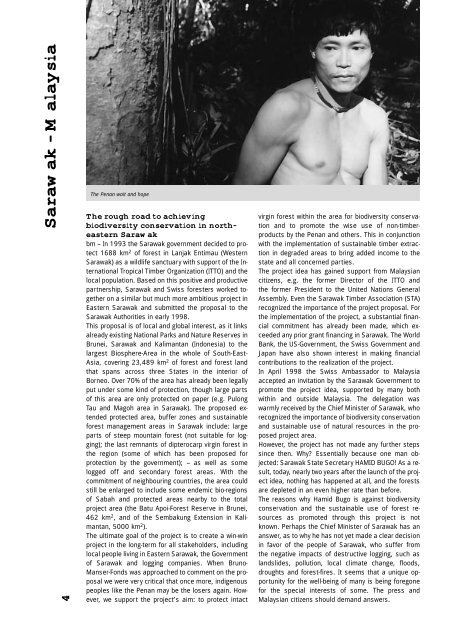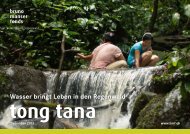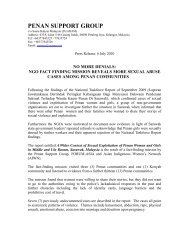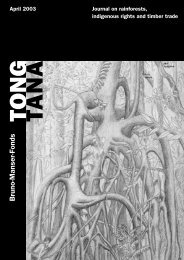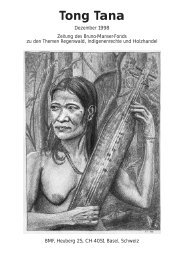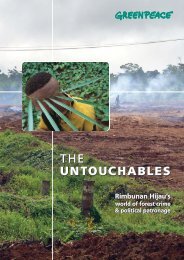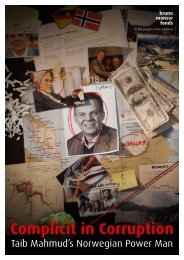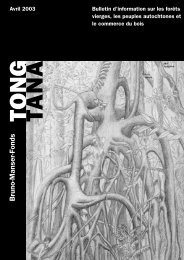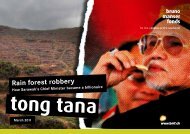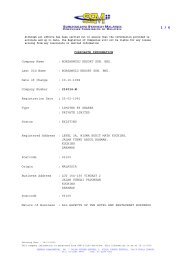Tong Tana December 1999 - Bruno Manser Fonds
Tong Tana December 1999 - Bruno Manser Fonds
Tong Tana December 1999 - Bruno Manser Fonds
Create successful ePaper yourself
Turn your PDF publications into a flip-book with our unique Google optimized e-Paper software.
Sarawak - Malaysia<br />
4<br />
The Penan wait and hope<br />
The rough road to achieving<br />
biodiversity conservation in northeastern<br />
Sarawak<br />
bm – In 1993 the Sarawak government decided to protect<br />
1688 km 2 of forest in Lanjak Entimau (Western<br />
Sarawak) as a wildlife sanctuary with support of the International<br />
Tropical Timber Organization (ITTO) and the<br />
local population. Based on this positive and productive<br />
partnership, Sarawak and Swiss foresters worked together<br />
on a similar but much more ambitious project in<br />
Eastern Sarawak and submitted the proposal to the<br />
Sarawak Authorities in early 1998.<br />
This proposal is of local and global interest, as it links<br />
already existing National Parks and Nature Reserves in<br />
Brunei, Sarawak and Kalimantan (Indonesia) to the<br />
largest Biosphere-Area in the whole of South-East-<br />
Asia, covering 23,489 km 2 of forest and forest land<br />
that spans across three States in the interior of<br />
Borneo. Over 70% of the area has already been legally<br />
put under some kind of protection, though large parts<br />
of this area are only protected on paper (e.g. Pulong<br />
Tau and Magoh area in Sarawak). The proposed extended<br />
protected area, buffer zones and sustainable<br />
forest management areas in Sarawak include: large<br />
parts of steep mountain forest (not suitable for logging);<br />
the last remnants of dipterocarp virgin forest in<br />
the region (some of which has been proposed for<br />
protection by the government); – as well as some<br />
logged off and secondary forest areas. With the<br />
commitment of neighbouring countries, the area could<br />
still be enlarged to include some endemic bio-regions<br />
of Sabah and protected areas nearby to the total<br />
project area (the Batu Apoi-Forest Reserve in Brunei,<br />
462 km 2 , and of the Sembakung Extension in Kalimantan,<br />
5000 km 2 ).<br />
The ultimate goal of the project is to create a win-win<br />
project in the long-term for all stakeholders, including<br />
local people living in Eastern Sarawak, the Government<br />
of Sarawak and logging companies. When <strong>Bruno</strong>-<br />
<strong>Manser</strong>-<strong>Fonds</strong> was approached to comment on the proposal<br />
we were very critical that once more, indigenous<br />
peoples like the Penan may be the losers again. However,<br />
we support the project’s aim: to protect intact<br />
virgin forest within the area for biodiversity conservation<br />
and to promote the wise use of non-timberproducts<br />
by the Penan and others. This in conjunction<br />
with the implementation of sustainable timber extraction<br />
in degraded areas to bring added income to the<br />
state and all concerned parties.<br />
The project idea has gained support from Malaysian<br />
citizens, e.g. the former Director of the ITTO and<br />
the former President to the United Nations General<br />
Assembly. Even the Sarawak Timber Association (STA)<br />
recognized the importance of the project proposal. For<br />
the implementation of the project, a substantial financial<br />
commitment has already been made, which exceeded<br />
any prior grant financing in Sarawak. The World<br />
Bank, the US-Government, the Swiss Government and<br />
Japan have also shown interest in making financial<br />
contributions to the realization of the project.<br />
In April 1998 the Swiss Ambassador to Malaysia<br />
accepted an invitation by the Sarawak Government to<br />
promote the project idea, supported by many both<br />
within and outside Malaysia. The delegation was<br />
warmly received by the Chief Minister of Sarawak, who<br />
recognized the importance of biodiversity conservation<br />
and sustainable use of natural resources in the proposed<br />
project area.<br />
However, the project has not made any further steps<br />
since then. Why Essentially because one man objected:<br />
Sarawak State Secretary HAMID BUGO! As a result,<br />
today, nearly two years after the launch of the project<br />
idea, nothing has happened at all, and the forests<br />
are depleted in an even higher rate than before.<br />
The reasons why Hamid Bugo is against biodiversity<br />
conservation and the sustainable use of forest resources<br />
as promoted through this project is not<br />
known. Perhaps the Chief Minister of Sarawak has an<br />
answer, as to why he has not yet made a clear decision<br />
in favor of the people of Sarawak, who suffer from<br />
the negative impacts of destructive logging, such as<br />
landslides, pollution, local climate change, floods,<br />
droughts and forest-fires. It seems that a unique opportunity<br />
for the well-being of many is being foregone<br />
for the special interests of some. The press and<br />
Malaysian citizens should demand answers.


